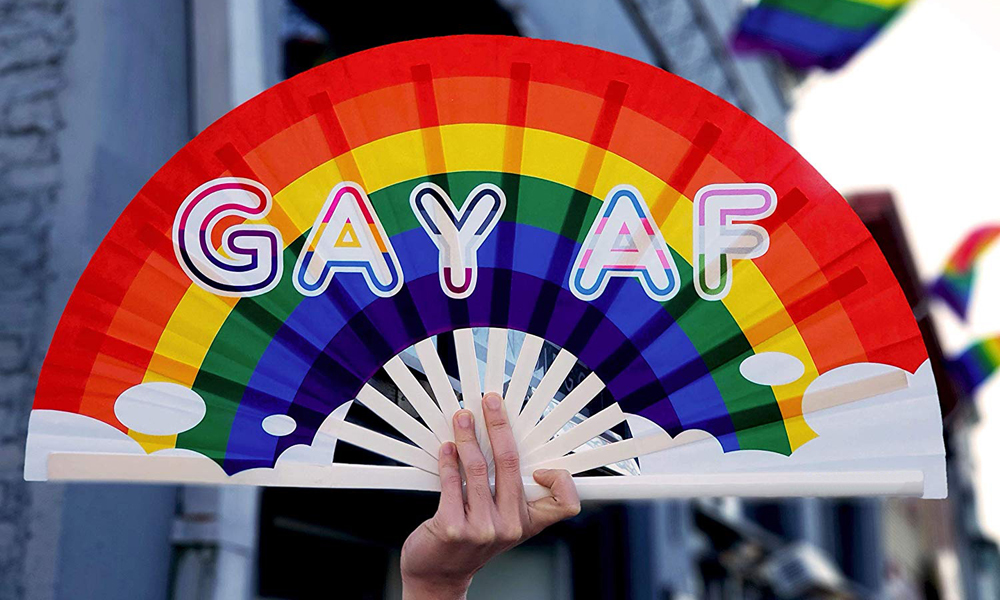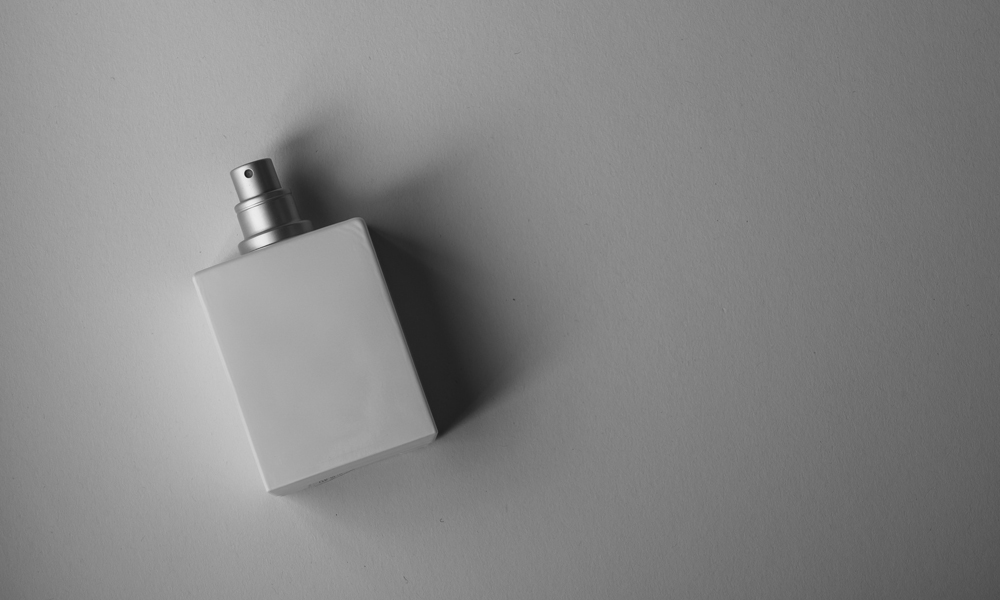Clack that fan!…
By Bobby Box
It was a simple topic, I thought: how we, the gay community, became synonymous with folding fans. You know the ones – those obnoxious handheld devices that make loud, ear-piercing sounds, producing a soundtrack at circuit parties. But I was wrong. Scouring the internet, I found zero information regarding our history with the item. I was equally dismayed to discover that it has nothing to do with Mortal Kombat’s Princess Kitana. (Because, credit where credit is due.)
While there is no reputable resource for its significance in queer culture, there is information available on how the item came to be in everyday society. First, the obvious: the folding fan was originally created to cool people down and not, as gays have adapted it, to be a clamorous method of expressing enthusiasm.
Artisans in seventh-century Japan invented the fan, creating their trademark fan using a set of sticks (made of wood, ivory, mother-of-pearl, etc.), assembled at each end and held together at the base by a rivet. The “leaf” of the fan, inspired by banana leaves, is a semi-circular piece of cloth, lace, etc. that is secured across the sticks. Its simple functionality, which has remained relatively unchanged, was inspired by the way a bat folds its wings.
The folding fan came to Europe in the 15th century via Catherine de Medici, the Queen of France, and it became regarded as a key item in the French court. Soon, the fan became a symbol of elegance, often found in the clutches of affluent women dressed in evening gowns seated in theatre boxes.
When folding fans came to North America in the 19th century, by way of advertising and travel, they had a similar influence on the wealthy, imparting an appearance of luxury. In 1908, the New York Times declared, “Of all the accessories of evening dress, the fan is perhaps of first significance.” Over time, however, the American passion for “Japonisme” (the influence of Japanese art and aesthetics on Western aesthetics) extended beyond the realm of fine art to mass consumption of everyday objects, like the kimono and parasol.
At one time, it was understood that there was significance attached to how one held, gestured, communicated or danced with the fan, and whether it remained open or closed. Now, at least in North America, folding fans have become far more commercialized.
How did it get from mainstream to gay culture?
In searching for an answer on the fan’s impact on queer culture I happened on a Reddit thread, where a user had the same question about its history. “I don’t think there is a ‘history.’ They are fun, they are sassy, they are used regularly for drag performances,” a commenter wrote. “And when you’re dancing non stop on drugs they have the practical purpose of cooling you off. They just sort of have a natural place at circuit parties. That’s like asking the history of furry clothing at raves. They feel good when you’re on E so they just sort of came to be naturally.”
That’s not a bad stab at an answer. Circuit parties are known for drugs and dancing, and it getsrealhot in there. A folding fan, paired with its aggressive flamboyance, compactness and booming sound, seems the perfect item to tuck in a jockstrap.
Still, I wasn’t entirely sold. So I posted on Twitter, calling for anybody who might have information. Again, I got nothing. Somebody suggested it might have birthed from ballroom culture, but any insight on that suggestion was nowhere to be found.
Then the clouds parted. Pablo Solomon, an award-winning designer, reached out to me. Given his credentials (which include studies in Asian art and design as well as an education in social anthropology), he’s confident that he can offer some reliable insights as to how the fan became associated with gay men.
“In past times, gays were not accepted in general [Western] society, so it was not unusual for gay men from Europe and America to live and work in places like Morocco, Thailand, Vietnam, China and so on, in order to follow their sexual inclinations,” he says. “The fan as an item of flirtation was taken to an art form in Spain, Japan and China. Since some gays were/are somewhat effeminate in their seductive personas, fans were part of their flirtatious repertoire.”
Over time, this predilection that gay men had for fans made its way to North America, where it served the same purpose whether it was being held by an affluent straight woman or a gay man: to convey opulence…and to get some dick.
While the origins of how the folding fan became an instrument for gays are uncertain, the reason for their popularity is understandable. Fans are feminine, campy and fabulous. Fans are striking and dramatic. Fans are great at cooling people down when dancing on drugs. All of these reasons make sense for why we love them so much, and maybe that’s the closest we will ever get to a reputable origin story.
As Elizabeth I of England supposedly said: a fan is the only suitable gift for a queen. It turns out, she was absolutely right.
—
BOBBY BOX is a prolific freelance journalist in Hamilton, Ont. He currently works as contributing editor at Playboy.com and has had the privilege of speaking with the world’s most recognized drag queens, including Trixie Mattel and Alaska Thunderfuck. While proud of his work, Bobby is not above begging. He asks that you follow him on Twitter at @bobbyboxington.






Edie / 20 February 2024
What I’d like to know is why are the fans gay men use so fucking tacky? Just like cheap polyester and plastic sticks. And the fans they use are giant too, which adds to the tacky impression. I love folding fans but I use handmade paper and wood fans from Kyoto, and they’re a nice compact size too.
55555 / 09 November 2023
“In past times, gays were not accepted in general [Western] society, so it was not unusual for gay men from Europe and America to live and work in places like Morocco, Thailand, Vietnam, China and so on, in order to follow their sexual inclinations,” he says. “The fan as an item of flirtation was taken to an art form in Spain, Japan and China. Since some gays were/are somewhat effeminate in their seductive personas, fans were part of their flirtatious repertoire.”?????
asian not feminine not gay OK we dont have this culture
Fans are feminine, campy and fabulous????
Cultural Appropriation folding fans is manly also girly
Skip Davis-Cochrane / 27 May 2021
Oh …hunty, don’t be a bitch, just be a queen!
Andre Ferreira / 27 November 2019
You don’t have to go as far back as the 15th century, or China/Japan. About 10 years ago, if you partied in Barcelona during Circuit Festival or in Madrid for NYE or Pride, fans were as ubiquitous as beards, muscles and tattoos are on circuit dance floors. Why? Simply because they were the only way to keep moderately cool in the dangerously packed and hot Spanish party spaces. Fans have always been a part of Spanish culture. Everyone’s grandmas and aunts sport one in the warm summer months. A symbol of femininity, they were quickly adopted in Spain’s queer culture in the 80s and 90s during the period known as La Movida Madrileña, a counterculture and subversive period of social liberation following the oppressive years of the Franco fascist dictatorship. Look up Locomía and you will understand. By 2010-2011, when gay North Americans discovered that partying in Spain was just way better, they quickly and annoyingly adopted the fan and ruined it for the rest of us. Thanks.